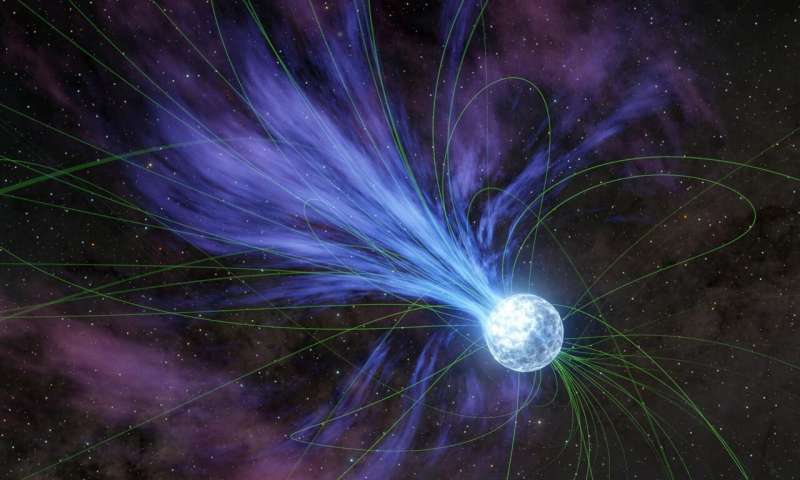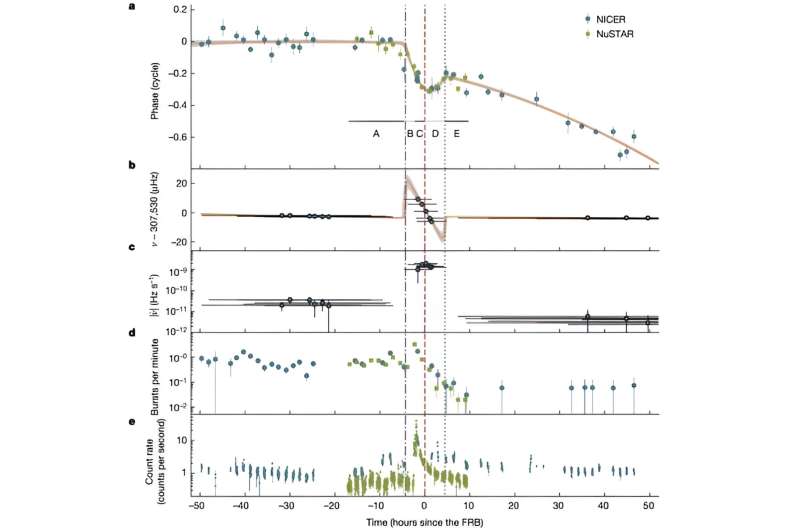This article has been reviewed according to Science X's editorial process and policies. Editors have highlighted the following attributes while ensuring the content's credibility:
fact-checked
trusted source
proofread
Another clue into the true nature of fast radio bursts

Fast radio bursts (FRBs) are strange events. They can last only milliseconds, but during that time can outshine a galaxy. Some FRBs are repeaters, meaning that they can occur more than once from the same location, while others seem to occur just once. We still aren't entirely sure what causes them, or even if the two types have the same cause. But thanks to a collaboration of observations from ground-based radio telescopes and space-based X-ray observatories, we are starting to figure FRBs out.
Most FRBs happen well beyond our galaxy, so while we can pin down their locations, it's difficult to observe any details about their cause. Then, in 2020, we observed a fast radio burst in our galaxy. Subsequent observations found that it originated in the region of a highly magnetized neutron star known as a magnetar.
This led to the idea that magnetars were the source of FRBs, possibly through magnetic flares similar to solar flares. But magnetars and sun-like stars are very different. It still wasn't clear how a magnetar could release such a tremendous amount of energy so quickly, even with their intense magnetic fields. Now a new study suggests the magnetar's rotation plays a key role.
The study, appearing on the pre-print server arXiv, focuses on the 2020 FRB magnetar. Known as SGR 1935+2154, it is both a magnetar and a pulsar. This means it emits a regular radio pop as it rotates.
Pulsars are incredibly regular and are used as a kind of cosmic clock for everything from studying gravitational waves to hypothetical navigation through the galaxy. But over time a pulsar's rotation slows down as rotational energy radiates away thanks to its magnetic field. By observing this rate of decay, astronomers can better understand the structure of neutron stars and magnetars.

But sometimes the rate of rotation will shift suddenly. It's known as a glitch if the rotation suddenly speeds up, and an anti-glitch if it suddenly slows down. These glitches are thought to occur when there's some kind of sudden structural change in the neutron star, such as a starquake.
In 2022, NASA's Nuclear Spectroscopic Telescope Array (NUSTAR) spacecraft and the Neutron Star Interior Composition Explorer (NICER) on the international space station both observed another fast radio burst from SGR 1935+2154. Together they had X-ray data on the magnetar before, during, and after the burst. The team then looked at radio observations during the same time and found a dip in the pulsar rotation rate during the burst. This implies a connection between rotation and burst.
Overall what the team observed was a fluttering of X-ray emissions from SGR 1935+2154 a bit before the burst, then a glitch in the rotation, the burst itself, and a return to the regular rotation rate. This is only one observation, but it looks like the magnetar had the magnetic energy ready to release before the burst, and the shift in rotation created the conditions necessary to generate the FRB.
More information: Chin-Ping Hu et al, Rapid spin changes around a magnetar fast radio burst, arXiv (2024). DOI: 10.48550/arxiv.2402.09291
Provided by Universe Today





















